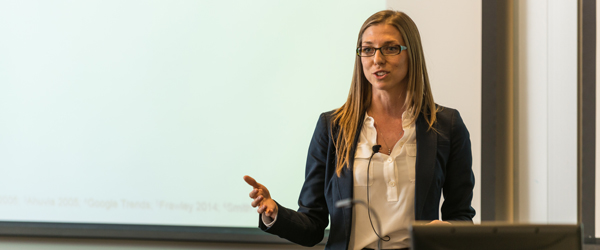Marketing in healthcare – Special Interest Group recap
The UW Center for Sales and Marketing Strategy was formed to link business professionals and academic researchers. One way to link academics and professionals is through programs like the Healthcare Special Interest Group (HSIG). The purpose of the HSIG is to bring the best marketing minds in healthcare together and come up with projects to develop new knowledge. The meeting was hosted by Robert Palmatier, research director of the Center for Sales and Marketing Strategy. John Henson, the VP of Medical Affairs from Swedish Hospital helped to facilitate the discussion.
The first meeting was designed to set the direction and future for the HSIG. The group decided to focus on creating value by sharing best practices in marketing. They agreed to have a topic for each future meeting and look at challenges facing the companies and healthcare industry. Marketing is often competitive, but the company representatives agreed that it is beneficial to work together.
One topic in the open discussion was the Shift in Marketing in the Healthcare Industry. The shift in marketing is from individuals to employers because employers choose the plan options for their employees. This is enterprise marketing, and healthcare companies have to market to both individuals and employers, and keep consumers involved and engaged. Otherwise the customers will choose a different plan. One example was the pressure from Boeing- healthcare practices changed and the speed of innovation improved. Employees can now choose between two plans: Swedish and UW Medicine
Companies want to market “wellness” so customers don’t visit doctors only when they’re sick. They want to shift the consumer thinking to: “I want to be well.” UW Medicine is only 12 years old, and the brand is 6 years old, so they are relatively new to marketing their company. Healthcare is being run like a business, creating a potential need for healthcare focused EMBA or other programs, but the market is small, so these would only be offered every 2-3 years
One challenge concerns the use of Technology in Medicine. UW Medicine recently introduced a program that allows patients to communicate with their doctors using video chat. Providence launched HealthExpress, a similar program in Washington. Getting consumers to engage with these new technologies requires marketing. Digital Healthcare is the fastest growing segment in healthcare. A problem the HSIG noted was that IT and medicine departments often do not communicate well. An additional concern is how to get customers who are offline to engage with these online offerings.
Behavior Change as a Marketing Endeavor, was another discussion topic as most marketing efforts go to behavior change. Problems included the determent issue with life insurance, financial services, and healthcare, and how companies can deal with the episodic nature of healthcare. The ACA (Affordable Care Act) is bringing thousands of new patients into the healthcare system, many of whom are getting coverage for the first time. One question is how to get them into the doctor for preventative care, rather than to the ER.
Loyalty Programs are very effective at creating behavior change. When using loyalty programs, companies should limit communication and communicate only when they have something new and improved to offer. For example, when airlines use random upgrades, customers feel gratitude (vs. “I earned those miles”). Surprising people is important. A concern for healthcare companies is finding loyalty cards that customers are motivated to use. Regulations about private healthcare data make accessing information about customers difficult. A potential research project would be to get people to volunteer to have health-related data recorded on a card and analyzed.
Finally, every local healthcare company can benefit from making Seattle a Healthcare Hotspot. Economic development attracts new businesses and creates a virtuous cycle. Washington has strong potential and a history of innovation. Seattle could be among the first cities to achieve the Triple Aim in healthcare (improving the patient experience of care, improving the health of populations, and reducing the per capita cost of healthcare.)

